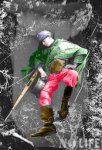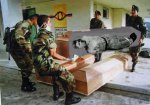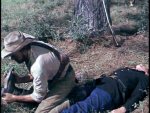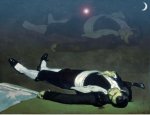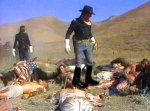Eh Arrow mate, we'll have to get you into recruit training so you can learn how to properly dress and carry yourself as a Highlander.
We have at the last count at least 14 orders of dress, from Combat (Fighting Order), barrack dress, to No 1 Dress Ceremonial (Royal duties)
No 2 dress Ceremonial is the more commonly used, it is hard to say how long it takes to don it, depends if you spend time the day before prepping kit, ie cleaning, brushing, ironing, polish brogues, whitening spats, all the time consuming things.
The basic kit is shirt (usually tan), kilt - 8 yard worsted wool, box pleated, Govt No 2 tartan - waist to 1" above top of knee cap, 3 clasps, sometimes pinned bottom right, horsehair sporran on leather strap, wool socks, tartan diced hose top, flashes held in place by garter, length of flashes and turn of the hose top have to be correct length, brogues (brush polished), spats - buttoned, tunic, medals and ribbons worn on left side upper, chest, Glengarry hat with regimental crest, some regiments wear a Hackle in the headdress.
There are variations on this for officers, duty officer, duty NCO, between battalions.
Main hassles - the brogues have metal studs in them to make a bigger noise on drill movements, can get slippery on hot surfaces in the summer, my pet hate - the spats - whitening them, they get stiff and hard to button, easier to share that with a mate, keeping kilt pleats pressed after putting the kilt on, sitting down is dangerous. Reckon on 1-2 hours prep time the night before and and hour to put it all on. Troops are inspected before parades to make sure no mistakes have been made, NCO s and Officers inspect each other.
Many men choose to be buried in No 2 dress but the Glengarry is taken off and put on the coffin often another over the dead man's chest, cap badge up.
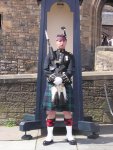


 uneral was a State Funeral, like Maggie is apparently going to get, technically not a military funeral I think, but as a former soldier Winnie would have been entitled to a military send off as well as for all the Royal Navy positions he held. Agree with Ivan, American uniforms are drab, we Brits do it better, most expensive uniforms are Household Cav and Highlanders, luckily its all paid for by the taxpayer.
uneral was a State Funeral, like Maggie is apparently going to get, technically not a military funeral I think, but as a former soldier Winnie would have been entitled to a military send off as well as for all the Royal Navy positions he held. Agree with Ivan, American uniforms are drab, we Brits do it better, most expensive uniforms are Household Cav and Highlanders, luckily its all paid for by the taxpayer.






